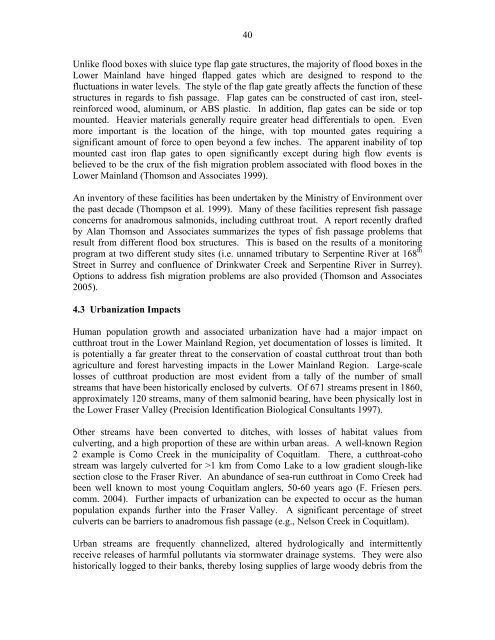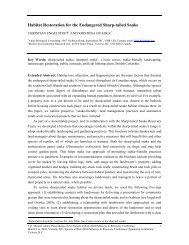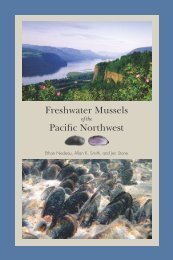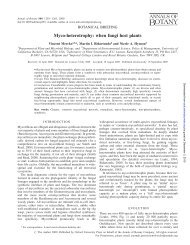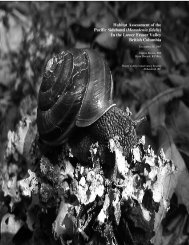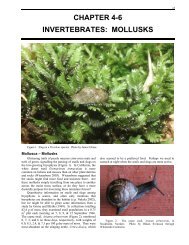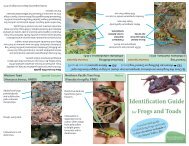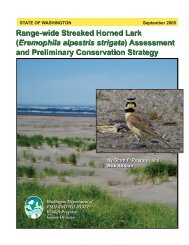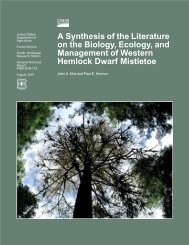Coastal Cutthroat Trout as Sentinels of Lower Mainland Watershed ...
Coastal Cutthroat Trout as Sentinels of Lower Mainland Watershed ...
Coastal Cutthroat Trout as Sentinels of Lower Mainland Watershed ...
You also want an ePaper? Increase the reach of your titles
YUMPU automatically turns print PDFs into web optimized ePapers that Google loves.
40Unlike flood boxes with sluice type flap gate structures, the majority <strong>of</strong> flood boxes in the<strong>Lower</strong> <strong>Mainland</strong> have hinged flapped gates which are designed to respond to thefluctuations in water levels. The style <strong>of</strong> the flap gate greatly affects the function <strong>of</strong> thesestructures in regards to fish p<strong>as</strong>sage. Flap gates can be constructed <strong>of</strong> c<strong>as</strong>t iron, steelreinforcedwood, aluminum, or ABS pl<strong>as</strong>tic. In addition, flap gates can be side or topmounted. Heavier materials generally require greater head differentials to open. Evenmore important is the location <strong>of</strong> the hinge, with top mounted gates requiring <strong>as</strong>ignificant amount <strong>of</strong> force to open beyond a few inches. The apparent inability <strong>of</strong> topmounted c<strong>as</strong>t iron flap gates to open significantly except during high flow events isbelieved to be the crux <strong>of</strong> the fish migration problem <strong>as</strong>sociated with flood boxes in the<strong>Lower</strong> <strong>Mainland</strong> (Thomson and Associates 1999).An inventory <strong>of</strong> these facilities h<strong>as</strong> been undertaken by the Ministry <strong>of</strong> Environment overthe p<strong>as</strong>t decade (Thompson et al. 1999). Many <strong>of</strong> these facilities represent fish p<strong>as</strong>sageconcerns for anadromous salmonids, including cutthroat trout. A report recently draftedby Alan Thomson and Associates summarizes the types <strong>of</strong> fish p<strong>as</strong>sage problems thatresult from different flood box structures. This is b<strong>as</strong>ed on the results <strong>of</strong> a monitoringprogram at two different study sites (i.e. unnamed tributary to Serpentine River at 168 thStreet in Surrey and confluence <strong>of</strong> Drinkwater Creek and Serpentine River in Surrey).Options to address fish migration problems are also provided (Thomson and Associates2005).4.3 Urbanization ImpactsHuman population growth and <strong>as</strong>sociated urbanization have had a major impact oncutthroat trout in the <strong>Lower</strong> <strong>Mainland</strong> Region, yet documentation <strong>of</strong> losses is limited. Itis potentially a far greater threat to the conservation <strong>of</strong> co<strong>as</strong>tal cutthroat trout than bothagriculture and forest harvesting impacts in the <strong>Lower</strong> <strong>Mainland</strong> Region. Large-scalelosses <strong>of</strong> cutthroat production are most evident from a tally <strong>of</strong> the number <strong>of</strong> smallstreams that have been historically enclosed by culverts. Of 671 streams present in 1860,approximately 120 streams, many <strong>of</strong> them salmonid bearing, have been physically lost inthe <strong>Lower</strong> Fr<strong>as</strong>er Valley (Precision Identification Biological Consultants 1997).Other streams have been converted to ditches, with losses <strong>of</strong> habitat values fromculverting, and a high proportion <strong>of</strong> these are within urban are<strong>as</strong>. A well-known Region2 example is Como Creek in the municipality <strong>of</strong> Coquitlam. There, a cutthroat-cohostream w<strong>as</strong> largely culverted for >1 km from Como Lake to a low gradient slough-likesection close to the Fr<strong>as</strong>er River. An abundance <strong>of</strong> sea-run cutthroat in Como Creek hadbeen well known to most young Coquitlam anglers, 50-60 years ago (F. Friesen pers.comm. 2004). Further impacts <strong>of</strong> urbanization can be expected to occur <strong>as</strong> the humanpopulation expands further into the Fr<strong>as</strong>er Valley. A significant percentage <strong>of</strong> streetculverts can be barriers to anadromous fish p<strong>as</strong>sage (e.g., Nelson Creek in Coquitlam).Urban streams are frequently channelized, altered hydrologically and intermittentlyreceive rele<strong>as</strong>es <strong>of</strong> harmful pollutants via stormwater drainage systems. They were alsohistorically logged to their banks, thereby losing supplies <strong>of</strong> large woody debris from the


